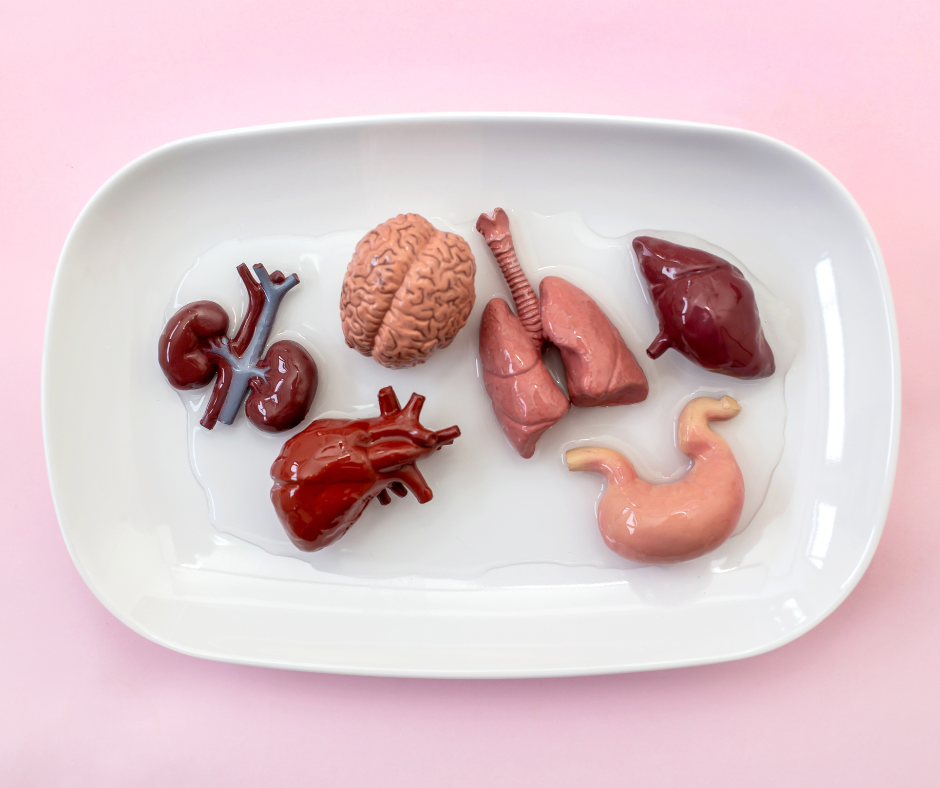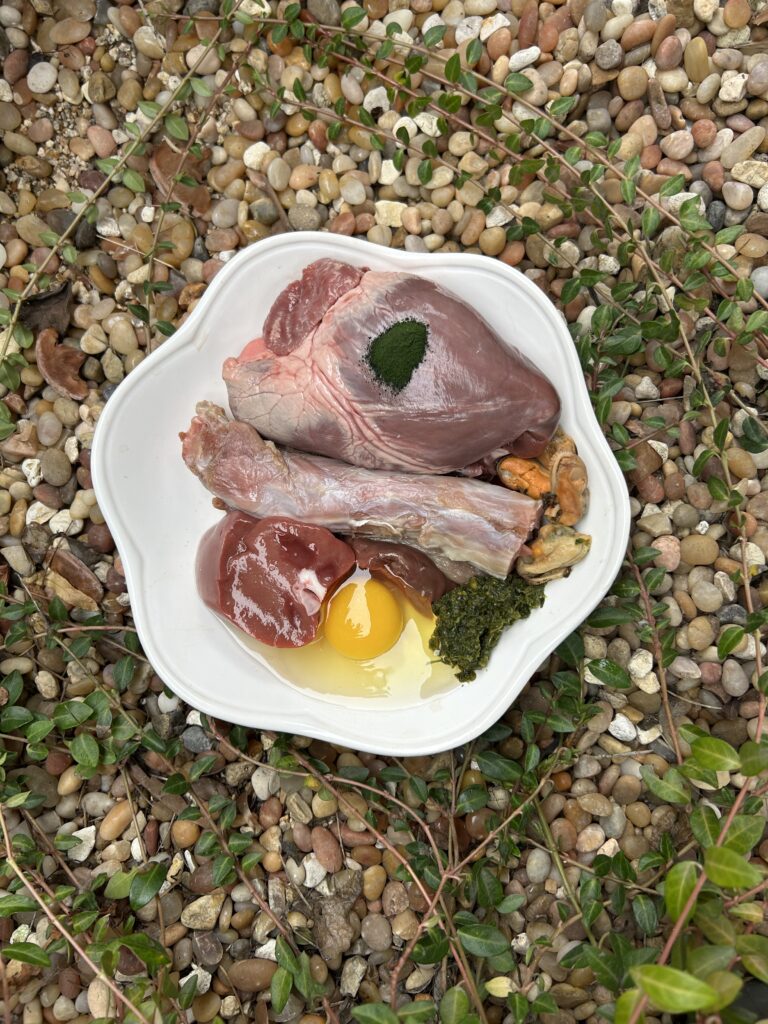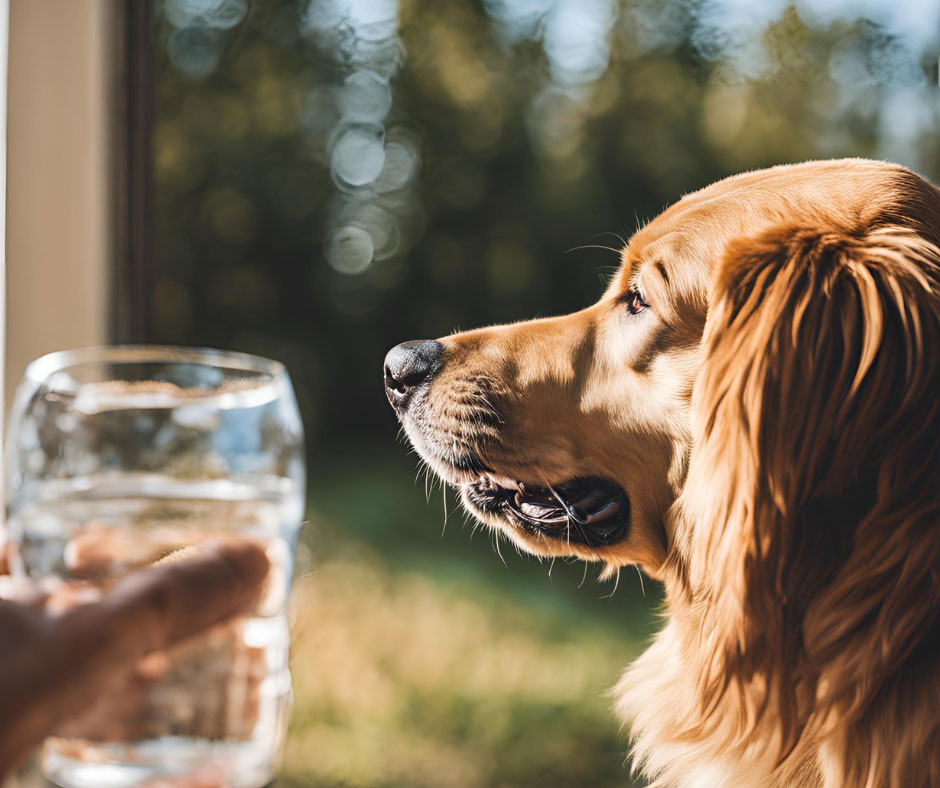
Organs are incredibly nutrient dense and are an integral part of a fresh food diet. Aside from some very specific exceptions, no fresh food diet for cats or dogs should be without organs. They provide a wide variety of vitamins and minerals in a very small package, which is great- you never want to have to feed a huge portion of something just to gain benefits.
When it comes to organs, the first and most important thing to understand is the difference between a muscular organ and a secreting organ. These basic definitions are necessary because if you’re using a fresh food calculator or trying to follow a feeding model, they’re likely only going to say ‘secreting organ’ and likely won’t tell you where or even if you should use a muscular organ. Hopefully this blog will provide some clarity there.
Once you understand that, the next step is to determine how much of each to feed, and which ones fit the diet you’re trying to create best. Most fresh feeding models, be it BARF, PMR or ancestral, recommend feeding 10% secreting organs, which is further split up into 5% liver and 5% other secreting organ. That other secreting organ can be one single other organ, or it could be a blend of multiple other secreting organs that adds up to 5%. However liver is a constant, and that will be explained below. If you don’t know what I’m talking about in terms of these percentages, read my other Nutrition Basics article about feeding amounts.
Muscular Organs
These are organs that have a composition most similar to muscle meats. They do not secrete anything and should be fed as part of the muscle meat portion. Examples of muscular organs include:
- eyes
- tongue
- heart
- lung
- green tripe (stomach)
- uterus
- poultry gizzards
One or multiple of these organs can be used in a meal, in any ratio you choose. If, for example, you use a fresh food calculator that tells you to feed 10oz of muscle meat, you could use a muscular organ as part or even all of that amount. So for this example, you could feed 2oz of lung, 2oz of heart and 6oz of ground beef to get to the total of 10oz. Or, you could feed 5oz of heart and 5oz of tripe. Another option is to feed all 10oz of lung, etc. Any combination works, as long as it works for your pet.
How would you know what works? Trial and error! When I first started feeding fresh food years ago, I was so hung up on the tinniest of details that I wasn’t able to experiment or break from the norm. As a matter of fact, I was so worried about my pets missing out on nutrients that I weighed each ingredient to the tenth of an ounce! Once I realized that this wasn’t necessary, it was very freeing, and I was able to truly figure out what worked best for my pets.
Secreting Organs
These are, as the name suggests, organs that secrete a hormone or enzyme. These tend to have different nutritional profiles depending on the organ. For example, spleen is usually higher in iron, while kidney is higher in selenium and liver is full of copper and vitamin A. Examples of secreting organs include:
- liver
- kidney
- pancreas
- spleen
- thyroid
- thymus
- brain
- testes and ovaries
There are some key factors to discuss when it comes to secreting organs. First, I strongly recommend sourcing them from grass fed and pastured animals whenever possible. Secreting organs often do more than just secrete substances- they sometimes filter them as well. Obvious example of this are the kidneys and liver. The liver ‘filters’ toxins using various metabolic pathways, and then the kidneys excrete those toxins in a different form of filtration through the nephrons, which are incredibly complex but delicate cells within the kidney that decide which substances stay and which leave the body through the urine. When animals are exposed to poor quality food, excessive environmental toxins, multiple rounds of antibiotics and more, their detox pathways become saturated, contaminated and damaged. This is the case for feedlot cows, caged chickens and penned pigs. When we consume these animals, or fed them to our pets, we’re feeding less than ideal cuts of organs that can actually lead to negative health outcomes rather than imparting the benefits we’re feeding them for. So, if you had to choose one category of ingredients to put your money toward, I would say spend the extra cash for top quality organs.
Some Organ Specifics…
I’d like to go over a couple of particulars about specific organs, so that you can feel confident feeding the ones that work best for you and your dog or cat. I’ll share some of my own experiences as well as general knowledge, and you can take that and run with it!

Heart
There’s a saying that floats around the internet that the max amount of heart to be fed shouldn’t exceed 20% of the muscle meat portion. I’m not sure where that came from, but it’s a myth with no scientific backing. I personally feed 100% of my muscle meat as muscular organs, and the one most available to me currently is heart. Above is an example of a bowl I made with pork heart as my muscle meat. If I had access to lung, I would use some lung and some heart as my muscle meat. And sometimes I do use other actual muscle meat cuts such as ground meat or pork shoulder or beef chuck, but it’s infrequent.
Heart is the organ highest in taurine, which is a conditional amino acid for dogs and an essential amino acid for cats. A taurine deficiency will lead to heart disease and can be catastrophic. Luckily, a fresh food diet is usually more than sufficient in taurine even without the use of heart, but if you do include it there’s really no question that the taurine is optimal. My cats love minced chicken, duck and turkey hearts and I’ll usually set a few aside when doing meal prep for them. Hearts are also the perfect size for dehydrating treats for dogs! I like to slice them in half so that they dehydrate more evenly, and then I store them in the refrigerator and bring them on hikes or use as a high value treat.
Tripe
Tripe, or green tripe as it’s usually called, is the first stomach from ruminants (beef, sheep, goat). The reason why it’s called green tripe is to differentiate it from regular tripe, which is bleached to be made safe for human consumption. Many Asian and middle eastern cultures consume tripe in soups and stews, but please understand that this form of tripe is NOT what you want to provide for your pets. The bleaching removes the beneficial digestive enzymes that are present in raw green tripe that are theorized to be so beneficial for our furry family members.
Tripe is high in manganese and has a great calcium to phosphorous ratio. People have used it for reported digestive benefits in pets with GI issues. It stinks to high heaven and many animals absolutely love the smell even though I personally want to wear a gas mask when handling it; I’ve even heard of it being able to entice a dog to eat when they refuse anything else.
One thing to know about green tripe, however, is that it can lead to diarrhea. It’s one of the foods that people like to describe as ‘rich’ and can cause the runs. Some pets can eat a whole bowl of green tripe and have the perfect poop. Others might eat one ounce of tripe and end up with loose stool. So when trying this out in the diet, I recommend starting with a very small amount of 1-2oz at most, and building up from there while monitoring stool consistency.
A personal input from me- my dogs do not tolerate green tripe well. They all get loose stool with small amounts and their stool also smells like tripe, which tells me that the actual absorption of nutrients and optimal digestion of the ingredient is not optimal. So we don’t include it in our diet, however if they didn’t have this reaction, I absolutely would include it as I do feel it hold many benefits, in particular the manganese content which is frequently deficient in homemade diets.
Pancreas
This is usually used for pets with pancreatic issues such as EPI (exocrine pancreatic insufficiency). When feeding pancreas for a medical condition, it usually needs to be prepared and stored a certain way and only lasts for a finite amount of time. This is because the enzymes in the pancreas (lipase, amylase, etc.) will degrade over time and are no longer viable. If you’re just feeding pancreas as another secreting organ without special needs, however, no specific prep needs to be done.
Testes & Ovaries
These organs are once again often used for pets who have a medical need- specifically those who have had their sex organs removed. Early spay and neuter syndrome is a big problem that can wreak havoc on many organ systems. Pet parents will sometimes feed these organs to replace those that have been lost.
Spleen
This organ is among the highest in iron, and one of my favorites to feed puppies who have a higher iron need while they’re still growing. This is also one of the organs that can make the stools look very dark or black, which is because of the iron content. If this happens when feeding spleen don’t panic, cut back on the spleen to confirm that’s the cause, and then you can resume based on consistency of stool rather than color. This is why it’s important to look at your dog’s excrement frequently!
Liver

Liver is an important secreting organ and should be included in all fresh food diets. Liver is extremely nutrient dense, but unfortunately, it’s also one of the organs most likely to be impacted by traditional or factory farmed practices which can lead to heavy metal contamination and more. Of all the organs, liver would be the most important to source from grass fed and pastured animals for this reason.
Another note is that liver from different species will have a vastly different nutritional profile. In general, liver from ruminants (beef especially, but also sheep and goat) is rich in vitamin A, copper, and iron. Liver from poultry (chicken, duck, turkey), while much lower in vitamin A and copper, tends to be an excellent source of B vitamins. Because of the nutritional differences, I mostly use ruminant liver but do like to rotate in poultry liver about 1/4 of the time. It’s also very important to know that pork liver does NOT have bioavailable copper. Therefore, I do not recommend using it routinely as your liver portion unless you’re feeding another ingredient high in copper that day, such as oysters.
Liver should be included in each meal, and makes up about 5% of the total food fed. Some people feed a little more or a little less and that’s fine, but this is one that I do think should be present for the nutritional value it brings that is unique and necessary.
Troubleshooting Organs
Organ Refusal
Truthfully, feeding organs can be nuanced and confusing, and that’s ok. Start slow with one organ at a time and see how your pet tolerates it. The consistency of organs can be off-putting, and the smell and taste can be strong because of the iron content. Many pets don’t know what to do with these new textures and smells and often refuse to eat organs at first because of them. Not to worry- you just need to be patient. I’ll share my own dog’s story as an example.
My smallest but older dog, Piper, is a bit of a princess. Not only does she rule the household as alpha dog, she likes things her way and is stubborn as heck, including when it comes to food. When we first embarked on the fresh food journey, she was completely on board from the first plate of raw chicken I set down in front of her. But when it came time to introduce organs a few days later, she took one sniff and ate everything else on the plate before walking away without even a lick. I was stumped- how could she like raw chicken but not raw liver?
The next day, the same thing happened. And then next, and the next. Each day I cut a slightly smaller portion size thinking it was too much, but no matter how little I put she would completely avoid it and eat around it. Finally, I took the tiniest portion, 1/4 of an ounce, and I made a slice in her chicken breast to create a pocket and stuffed the liver in there. She ate it! I did that for a few days before increasing the amount to 1/2 of an ounce, still hiding it inside the chicken. Then, I began to smash the liver in with the chicken so that it was on the outside but couldn’t be separated. She tentatively ate it. Each day, she was more comfortable until finally there was no hesitation. This is when I finally placed the liver on the plate next to the chicken and she ate it all no problem.
I thought the mystery was solved…. until I introduced kidney. Well, we were back to square one. But using the same method, not she eats big chunks of kidney no problem whatsoever. It’s all about acclimating them to something new that is quite different from regular meat in terms of both texture, taste and smell. Interestingly enough, she had no issues with tripe… too bad it gives her the runs!
The Scoop on Poop
While it’s true that too many organs can sometimes lead to loose stool, I’ve found over the years that this isn’t usually an exclusive cause. At first, when the body isn’t used to a lot of organ content in the diet, sure- maybe we get some GI upset. That can be true of anything new. But increasing the amount of an organ in the diet of a dog who has been eating fresh for a long time just shouldn’t cause severe stool quality issues. If this happens down the line, look to the amount of fiber in the diet before just assuming that it was the organs doing you in. My caveat with this is green tripe, which I mentioned above.
The high iron content in organs can made stools a little darker. This is because blood and iron that have been digested turn the stool black. This is normal, but unfortunately it can also mask actual issues. My goal is to have mid to dark brown stools that are firm, shaped, and easy to pick up. If I feed more organs and the stools turn black, I cut back. Not because it’s harming the dog in any way, but because if there was some kind of actual bleeding issue up higher in the GI tract that would normally show up as black stool, I would be masking it by already having stool that is too dark from my organ content. An example of something that could cause black stools would be a stomach ulcer, or an intestinal tumor- things that can slowly cause bleeding but no other noticeable symptoms. This is likely the only reason why I could cut back on my secreting organ intake. Muscular organs are much less likely to lead to black stool.
Lastly, I’ve seen people recommend increasing organ content for dogs with constipation. This is not something I recommend. Once again, I would look to the amount of fiber in the diet first. Then, if necessary, the bone content should be addressed. Too much bone can lead to constipation. However, the remedy for that generally should be to feed less bone or feed more fiber. Not to compensate with organs.
Sourcing
Where can you find organs? Lot’s of places! Asian and ethnic markets are excellent resources. I personally like 99 Ranch, which are pretty prevalent in California. Whole Foods Market grocery stores also tend to carry chicken hearts, beef liver and beef kidney. You can check both the fresh meat counter as well as the frozen meat section. When in doubt, ask the butcher. Speaking of which, local butcher’s shops can also be a good place to source organs. They sometimes even have organs if hunters bring them an animal to process, and may give you cuts for free. It never hurts to ask.
Another resource is local co-ops. These places usually have organs for sale in bulk, which is more affordable and excellent for those who meal prep like me. For example, I can get chicken hearts from my co-op for about $2/lb, vs $4/lb at Whole Foods. That makes a difference when I need 50lbs of heart per month! I have a list of co-ops by state under the resources tab, or you can click here. Finally, national distributors will ship frozen organs to your home, and there are many to choose from. I have a few listed under the same link as the co-ops above.
That’s it!
Now you’re an expert, so get out there and feed those organs with confidence! Remember that it’s ok to do your own thing and have your own ratios, and what works for one dog may not work for another. And don’t panic if you’re having trouble sourcing them locally either- there are many online companies who will ship to you. You can always come back to this article for some trouble shooting or reach out to me for help if needed. Happy organ hunting!


